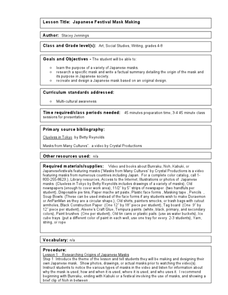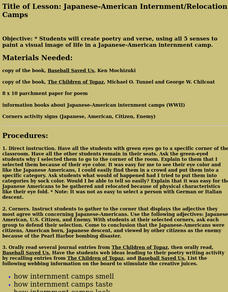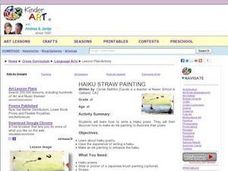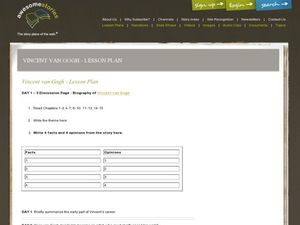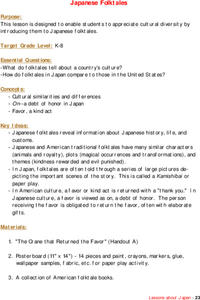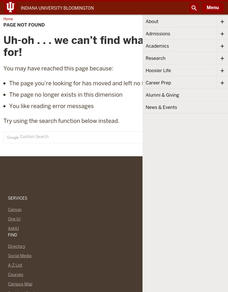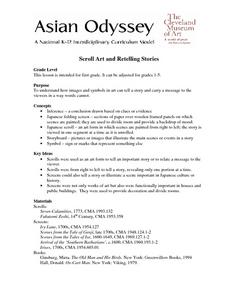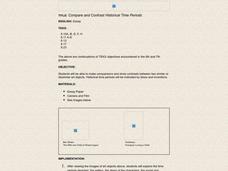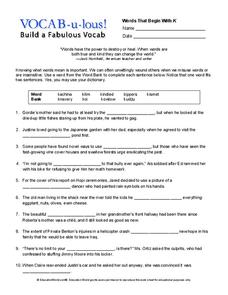Curated OER
Creating Scrolls Based on the Illustrated Tale of Genji
Now these are learning activities full of fun, art, and cultural exploration. Kids consider the art of storytelling through comic book images. They then look at the Tale of Genji as it was written in the 11th century. They discuss...
Cleveland Museum of Art
Japanese Folktales (Asian Odyssey)
The Cleveland Museum of Art presents this interdisciplinary model unit that asks class members to explore how the same themes are presented in the folktales and art of several cultures.
Curated OER
Gyotaku Lesson Plan
Students study the Japanese art of fish painting called Gyotaku while examining the lifestyle of Japanese fishermen at the end of the Edo period. They make a Gyotaku fish print and write a haiku poem using the proper number of syllables...
Curated OER
Japanese Festival Mask Making
Students learn about Japanese culture and make a mask. In this lesson about Japanese mask-making, students use research and art to explore the Japanese culture. Students research Japanese masks. Students design their own Japanese mask....
Curated OER
Art and Literature Quiz 4
In this art and literature instructional activity, students answer short answer questions about famous books, authors, characters, and more. Students complete 20 questions.
Curated OER
Integrating Japanese Folk Tales into the Classroom Using Japanese Kamishibai
Students study Japanese folk tales focusing on the traditional values and key elements. They compare the Japanese values with their own. They discuss Japanese art before designing a set of kamishibai on which they write a summary of a...
Curated OER
Japanese-American Internment/Relocation Camps
Learners create poetry and verse, using all 5 senses to paint a visual image of life in a Japanese-American internment camp.
Curated OER
Language Arts: Conversing with an Object
Students sharpen their creative writing skills by writing dialogues with unfamiliar objects while visiting local museums. They select an object in the museum, such as a painting, and create conversations between the people or animals...
Curated OER
Haiku Straw Painting
Pupils explore haiku poetry, have the experience of writing a haiku, and make an ink painting to enhance the haiku.
Curated OER
Awesome Stories: Vincent van Gogh
Who was Vincent van Gogh? Most of the questions can be answered in two or three sentences; however, there is at least one essay prompt and one personal response question that require longer answers. Questions call for a good mix of...
Curated OER
Japanese Folktales
Students identify that Japanese folktales reveal information about Japanese history, life, and customs. Students identify and interpret the work kamishibai, paper play and explain that in Japanese folktales are told through a series of...
Curated OER
GREEK MYTH IN PAINTING
Second graders look closely at a Renaissance painting depicting an ancient Greek myth, review the term renaissance, hear a Greek myth that tells how the peacock got its tail, sequence the story, and identify the actions of the myth in...
Curated OER
The Poetry of Chinoiserie
Students study Asian works of art and Japanese haiku. They then take this knowledge and create an original haiku in response to other works of art.
Curated OER
Noh Theater
Learners take a closer look at Japanese drama. In this Japanese culture lesson, students study the attributes of Noh theater and compare it western theater. Learners conduct independent research on the art form prior to acting out a Noh...
Curated OER
Writing Japanese Stories (Grades 6-8)
Young scholars listen to several Japanese stories and write their own Japanese-style stories, which they share with the class.
Curated OER
Scroll Art And Retelling Stories
Students create Japanese scroll art that represents a familiar folktale in this elementary school lesson that can be adapted for small group, or individual projects depending on ability.
Curated OER
Passionate Pilgrims- Two Poets And A Painter
Students engage in a lesson that looks at the culture of Japan to isolate the practices of painting and writing in several different traditions. They conduct research about the lives of the artists using a variety of resources. The...
Curated OER
COMPARE AND CONTRAST HISTORICAL TIME PERIODS
Students make comparisons and show contrasts between two similar or dissimilar art objects. Historical time periods will be indicated by dress and inventions.
Curated OER
Word Play
Pupils examine the Japanese folktale, Monkeys Grasp for the Moon. In this multicultural literature lesson, students discuss the theme of the folktale. Pupils choose animal folktales from other Asian cultures for comparison.
Curated OER
Historical Witness: Social Messaging
Research European expansionism and colonialism during the Age of Exploration. Study the Marquise de Miramon and discuss the objects from Japan. Research Europe's expansionism and colonialism during the Age of Exploration by working in...
Indiana University
World Literature: "One Evening in the Rainy Season" Shi Zhecun
Did you know that modern Chinese literature “grew from the psychoanalytical theory of Sigmund Freud”? Designed for a world literature class, seniors are introduced to “One Evening in the Rainy Season,” Shi Zhecun’s stream of...
National Endowment for the Humanities
Hamlet and the Elizabethan Revenge Ethic in Text and Film
Young scholars research the social context of Elizabethan England for Shakespeare's "Hamlet". They identify cultural influences on the play focusing on the theme of revenge and then analyze and compare film interpretations of the play.
Curated OER
Creating Scrolls Based on the illustrated TALE OF GENJI
Students identify formal elements that characterize the scroll, work in a variety of media, from traditional to digital, to create their own scrolls, work into digital printout with at least two media, and engage in meaningful critiques...
Curated OER
Vocab-u-lous! Build a Fabulous Vocab
In this vocabulary worksheet, students determine the best choice from the word bank to complete the sentence. All words are challenging and start with the letter "K."



